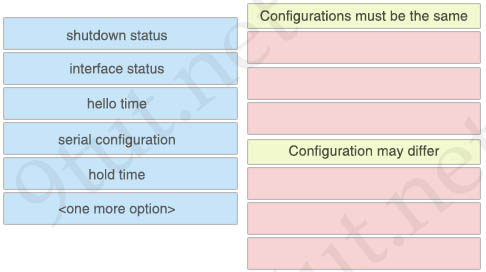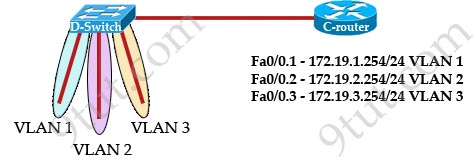ICND2v3 – New Questions Part 5
Premium Members: You can practice these questions with our quizzes first here.
Question 1
What protocols are supported by trunking? (Choose two)
A. DTP
B. PagP
C. LACP
D. STP
E. VTP
F. 802.1Q
Answer: A F
Question 2
What can be used to modify ToS field in IPv4 and traffic class on IPv6 header?
A. Shaping
B. Prioritising
C. Policing
D. Marking
Answer: D
Question 3
How would you fix connectivity issue between R1 and R2?
Configurations:
R1: int s0/0
ip add x.x.1.1 255.255.255.0
router bgp 100
network x.x.0.0
neighbor x.x.1.2 remote-as 200
R2: int s0/0
ip add x.x.1.2 255.255.255.0
router bgp 100
network x.x.0.0
neighbor x.x.1.1 remote-as 100
A. add the network mask /24 to the network command
B. configure the serial interface with no shutdown
C. replace the router bgp 100 command on R2 with router bgp 200
Answer: C
Question 4
R1 and R2 are connected via Gigaethernet0/0, R1 loses connectivity to R2, what will be your first step of troubleshooting?
A. make sure the encapsulation on R1 and R2 is set to HDLC
B. verify that g0/0 on R1 is up and line protocol down
C. verify that g0/0 on R2 is up and line protocol down
D. verify that g0/0 on R1 and R2 is up and line protocol up
Answer: D
Question 5
Drag and Drop question. Why router R1 doesn’t form an OSPF link with R2?

Answer:
Configurations must be the same:
+ shutdown status
+ hello time
+ hold time
Configuration may differ:
+ interface status
+ serial configuration
+ <one more option>
=============================== New Updated Questions (added on 2nd-May-2019) ===============================
Question 6
Which version of SNMP first allowed user-based access?
A. SNMPv3 with RBAC
B. SNMPv3
C. SNMPv1
D. SNMPv2
Answer: B
Explanation
The user-based access control implemented by SNMPv3 is based on contexts and user names, rather than on IP addresses and community strings. It is a partial implementation of the view-based access control model (VACM).
Question 7
Drag drop about EIGRP K values.
Answer:
K1 – bandwidth
K2 – load
K3 – delay
K4 – Reliability
K5 – MTU
=============================== New Updated Questions (added on 22nd-May-2019) ===============================
Question 8
What routing protocols are supported on stub routers? (Choose two)
or
Which routing protocols are compatible with stubs? (Choose two)
A. RIP
B. EIGRP
C. IS-IS
D. OSPF
E. BGP
Answer: B D
Explanation
Both EIGRP and OSPF support stub areas.
In OSPF, stubs remove either external routes and/or inter-area routes and tends to replace them with a default route. The general idea is that if you have 200 routes in your routing table, the branch doesn’t necessarily need that level of detail and if it is a smaller Cisco 800 or such then it may not do well with a ton of routes.
In EIGRP, stubs work similar but its main goal is to optimize the EIGRP network by stopping the branch for being queried when the hub has a route become active so the route doesn’t become stuck in active as the hub asks all the branches that probably don’t have the route anyway.
Question 9
Refer to the exhibit:

C-router is to be used as a “router-on-a-stick” to route between the VLANs. All the interfaces have been properly configured and IP routing is operational. The hosts in the VLANs have been configured with the appropriate default gateway. What can be said about this configuration?
A. These commands need to be added to the configuration:
C-router(config)# router eigrp 123
C-router(config-router)# network 172.19.0.0
B. No further routing configuration is required.
C. These commands need to be added to the configuration:
C-router(config)# router ospf 1
C-router(config-router)# network 172.19.0.0 0.0.3.255 area 0
D. These commands need to be added to the configuration:
C-router(config)# router rip
C-router(config-router)# network 172.19.0.0
Answer: B
Question 10
DHCP can be prevented by which protocol?
A. VTP
B. DTP
C. 802.1q
D. STP
Answer: D
Explanation
When a host is connected to a switchport, we have to wait for about 50 seconds in order to STP to turn on the port. In this time DHCP cannot assign an IP address for the host. If we want STP to transit to forwarding state immediately we need to issue the “switchport portfast” command.


thanks when will this be updated further?
i passed my icnd 2 some days ago. i got the pagp drag and drop. also a drag and drop about the k values. ospf ad. same sims eigrp and gre. not very difficult exam. 866/811. good luck guys
Are there much multi choice from the new questions v3 or 4?
Took my exam yesterday (2/4/19), questions from the New Questions sections are valid! I had about 70-80% of the questions from these sections. And coming to sims, I had the same GRE multilink and EIGRP sim but slightly different questions. As long as you know the concept well and go through everything on 9tut, you’re good to go.
All the best!
Today I passed ICND2, and now I have unique new questions. I can sell them for a small amount, be prepared for the exam. abekeenu @ gmail.com
more new questions please
Ops, no questions are updated after this
icnd2 Thursday 5/30/2019
What is true about eBGP peers (2 answers)
A-Interfaces must be in the same subnet
B-they must be in the same autonomous system
C-interfaces have to be directly connected
D-they must be on different autonomous systems
E- ???????????????????
I personally choose A and D